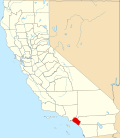San Juan Capistrano, California | |
|---|---|
Top: San Juan Mission Basilica (left), San Juan Capistrano station (right); middle: Mission San Juan Capistrano; bottom: Downtown San Juan Capistrano | |
| Motto: "Preserving The Past To Enhance The Future" | |
 Location of San Juan Capistrano within Orange County, California. | |
| Coordinates: 33°29′58″N117°39′42″W / 33.49944°N 117.66167°W | |
| Country | United States |
| State | California |
| County | Orange |
| Founded | November 1, 1776 |
| Incorporated | April 19, 1961 |
| Named after | John of Capistrano |
| Government | |
| • Type | Council-Manager |
| • Mayor [1] | Troy A. Bourne |
| • Mayor Pro Tem | John Campbell |
| • City Council | Sergio Farias Howard Hart John Taylor |
| • City manager [2] | Benjamin Siegel |
| Area | |
• Total | 14.43 sq mi (37.37 km2) |
| • Land | 14.43 sq mi (37.37 km2) |
| • Water | 0 sq mi (0.00 km2) |
| Elevation | 121 ft (37 m) |
| Population (2020) | |
• Total | 35,196 |
| • Density | 2,439.3/sq mi (941.82/km2) |
| Time zone | UTC-8 (Pacific) |
| • Summer (DST) | UTC-7 (PDT) |
| ZIP Code | 92675 |
| Area code | 949 |
| FIPS code | 06-68028 |
| GNIS feature IDs | 1661383, 2411793 |
| Website | sanjuancapistrano.org |
San Juan Capistrano (san hwaan cap-ih-STRAH-noh; also known colloquially as San Juan or SJC) is a city in southern Orange County, California, United States. The population was 35,253 at the 2020 Census.
Contents
- History
- Indigenous
- Spanish era
- Mexican era
- American era
- Geography
- Biogeography (San Juan Capistrano)
- Climate
- Demographics
- 2020
- 2010
- Economy
- Top employers
- Arts and culture
- Registered Historic Places
- Government
- Crime
- Education
- Media
- Transportation
- Rail
- Highways
- Water Services
- Sister cities
- Notable people
- References
- External links
Named for Saint John of Capistrano, San Juan Capistrano was founded by the Spanish in 1776, when Father Junípero Serra established Mission San Juan Capistrano. Extensive damage caused by an earthquake in 1812 caused the community to decline. Following the Mexican secularization act of 1833, the mission village officially became a town and was briefly renamed as San Juan de Argüello. After the American conquest of California, San Juan remained a small, rural town until the 20th century; the restoration of the mission in the 1910s–20s transformed the town into a tourist destination and a backdrop for Hollywood films.


























